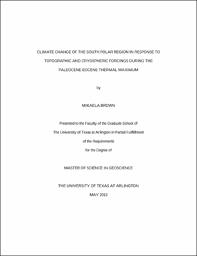
ATTENTION: The works hosted here are being migrated to a new repository that will consolidate resources, improve discoverability, and better show UTA's research impact on the global community. We will update authors as the migration progresses. Please see MavMatrix for more information.
Show simple item record
| dc.contributor.advisor | Winguth, Arne M. E. | |
| dc.contributor.advisor | Nestell, Merlynd K. | |
| dc.creator | Brown, Mikaela | |
| dc.date.accessioned | 2019-05-28T20:10:22Z | |
| dc.date.available | 2019-05-28T20:10:22Z | |
| dc.date.created | 2019-05 | |
| dc.date.issued | 2019-05-03 | |
| dc.date.submitted | May 2019 | |
| dc.identifier.uri | http://hdl.handle.net/10106/28096 | |
| dc.description.abstract | The Paleocene-Eocene thermal maximum (PETM) occurred approximately 56 Ma and is marked by an estimated global temperature increase of 5 °C, a large negative carbon and oxygen excursion, and deep-sea carbonate dissolution. Determining the factors that contributed to and amplified this short-term global warming episode is essential to better understand the rapid responses of the climate system to perturbations in the carbon cycle. In this study, we utilize the fully coupled Community Earth System Model version 1.2 to assess the role of global topography on the climate of the South Polar Region during the PETM. When comparing the present-day topography (including ice sheets) to the topography of the PETM, a significant increase in surface air temperature is simulated, which agrees with previous studies. An increase of PETM precipitation over the Southern Ocean relative to present is linked to this warming, due to the higher atmospheric vapor concentration. A reduced meridional temperature gradient and the absence of ocean gateways near Antarctica in the PETM causes a decrease of the oceanic barotropic stream function. Ventilation of water masses inferred from the global meridional overturning circulation and an idealized age tracer in the Pacific and Atlantic Oceans suggest an increased poleward heat transport during the PETM, which is also supported by weakening western boundary currents. In summary, Eocene to present-day topographic and cryospheric differences lead to changes in atmospheric and oceanic circulation and heat transport, and consequentially impact the climatic responses globally. The opening of Southern Ocean gateways could potentially be linked to the transition to the cooler climate of the Eocene/Oligocene boundary. | |
| dc.format.mimetype | application/pdf | |
| dc.language.iso | en_US | |
| dc.subject | Paleocene-Eocene thermal maximum | |
| dc.subject | Southern Ocean gateways | |
| dc.subject | Topographic forcing | |
| dc.subject | Cryospheric forcing | |
| dc.title | Climate Change of the South Polar Region in response to topographic and cryospheric forcings during the Paleocene-Eocene thermal maximum | |
| dc.type | Thesis | |
| dc.degree.department | Earth and Environmental Sciences | |
| dc.degree.name | Master of Science in Earth and Environmental Science | |
| dc.date.updated | 2019-05-28T20:10:54Z | |
| thesis.degree.department | Earth and Environmental Sciences | |
| thesis.degree.grantor | The University of Texas at Arlington | |
| thesis.degree.level | Masters | |
| thesis.degree.name | Master of Science in Earth and Environmental Science | |
| dc.type.material | text | |
| dc.creator.orcid | 0000-0001-6060-500X | |
Files in this item
- Name:
- BROWN-THESIS-2019.pdf
- Size:
- 1.669Mb
- Format:
- PDF
This item appears in the following Collection(s)
Show simple item record


